
Several reports prior to Japan's attack on Pearl Harbor in 1941 indicated that the base was vulnerable to attack. This has sometimes been noted in Pearl Harbor advance-knowledge conspiracy theories.

Several reports prior to Japan's attack on Pearl Harbor in 1941 indicated that the base was vulnerable to attack. This has sometimes been noted in Pearl Harbor advance-knowledge conspiracy theories.

In 1925, Gen. Billy Mitchell published a report called Winged Defense revealing the vulnerability of Pearl Harbor to a surprise air attack. Mitchell predicted that such an attack would effectively neutralize the Pacific fleet as part of a Japanese invasion of the Philippines. [1]
Two mock air attacks on Pearl Harbor during war games in the 1930s were judged to have been a success. [2] Shortly after taking office, Navy Secretary Knox wrote an overview memo which specifically noted the possibility of an attack at Pearl Harbor. However, neither observation led to formal policy recommendations to forestall such an attack. Admiral James O. Richardson, who was fired by President Roosevelt for complaining about the President's order to station the Pacific Fleet in Pearl Harbor instead of its normal berthing on the U.S. West Coast, [3] blamed the President for the "initial defeats in the Pacific" as "direct, real and personal." [4] Richardson believed stationing the fleet in Pearl Harbor made the ships extremely vulnerable against attack and provided a poor and unstrategic defense. [5]

The British proved that torpedoes could be effective in their attack on the Regia Marina at Taranto on November 11, 1940. The U.S. Navy discussed this new development as can be seen in a June 1941 memo. [6] The British attack method was not considered relevant to a torpedo attack at Pearl, as Taranto was about 75 ft (23 m) deep and Pearl less than 40 ft (12 m).
The Royal Navy had used Swordfish torpedo biplanes, and their low speed was part of the reason the Taranto attack succeeded. The Imperial Japanese Navy no longer had any similar planes, so they had to develop other methods, both hardware and delivery technique. They independently developed shallow water torpedo modifications (called "Thunder Fish") during the planning and training for the attack in 1941. Wooden fins were added to the tail and anti-roll "flippers" kept the torpedo upright once in the water. The fins kept the torpedo's nose level in the air and broke off on entering the water. The flatter "flight" trajectory helped keep them from diving so deeply as to encounter bottom mud. (Despite these modifications, some Japanese torpedoes did indeed reach the bottom and several remain unaccounted for.) These simple modifications were not anticipated by the USN, and Admiral Claude C. Bloch (commander of the Pearl Harbor Naval District) did not push to install torpedo nets or baffles at Pearl. Nor, it seems, did anyone else. Practical considerations also were an influence. Due to the shallow anchorage (which continues to require regular dredging), installation of torpedo nets would have severely restricted the mobility of vessels in the harbor.
Kimmel and his staff testified regarding torpedo nets and booms: "(m) Fact XV ... The decision not to install baffles appears to have been made by the Navy Department." [7] That is, in Washington, DC, rather than in Hawaii.

Isoroku Yamamoto was a Marshal Admiral of the Imperial Japanese Navy (IJN) and the commander-in-chief of the Combined Fleet during World War II. Yamamoto held several important posts in the Imperial Navy, and undertook many of its changes and reorganizations, especially its development of naval aviation. He was the commander-in-chief during the early years of the Pacific War and oversaw major engagements including the attack on Pearl Harbor and the Battle of Midway. Yamamoto was killed in April 1943 after American code breakers identified his flight plans, enabling the United States Army Air Forces to shoot down his aircraft.
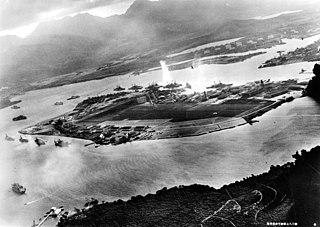
The attack on Pearl Harbor was a surprise military strike by the Imperial Japanese Navy Air Service on the American naval base at Pearl Harbor in Honolulu, Hawaii, in the United States, just before 8:00 a.m. on Sunday, December 7, 1941. At the time, the United States was a neutral country in World War II. The attack on Hawaii and other U.S. territories led the United States to formally enter World War II on the side of the Allies the day following the attack, on December 8, 1941. The Japanese military leadership referred to the attack as the Hawaii Operation and Operation AI, and as Operation Z during its planning.

A torpedo bomber is a military aircraft designed primarily to attack ships with aerial torpedoes. Torpedo bombers came into existence just before the First World War almost as soon as aircraft were built that were capable of carrying the weight of a torpedo, and remained an important aircraft type until they were rendered obsolete by anti-ship missiles. They were an important element in many famous Second World War battles, notably the British attack at Taranto, the sinking of the German battleship Bismarck, the sinking of the British battleship HMS Prince Of Wales and the British battlecruiser HMS Repulse and the Japanese attack on Pearl Harbor.

Husband Edward Kimmel was a United States Navy four-star admiral who was the commander in chief of the United States Pacific Fleet (CINCPACFLT) during the Japanese attack on Pearl Harbor. He was removed from that command after the attack, in December 1941, and was reverted to his permanent two-star rank of rear admiral due to no longer holding a four-star assignment. He retired from the Navy in early 1942. The United States Senate voted to restore Kimmel's permanent rank to four stars in 1999, but President Clinton did not act on the resolution, and neither have any of his successors.

The Battle of Taranto took place on the night of 11/12 November 1940 during the Second World War between British naval forces, under Admiral Andrew Cunningham, and Italian naval forces, under Admiral Inigo Campioni. The Royal Navy launched the first all-aircraft ship-to-ship naval attack in history, employing 21 Fairey Swordfish biplane torpedo bombers from the aircraft carrier HMS Illustrious in the Mediterranean Sea.

USS Northampton (CL/CA-26) was the lead ship in Northampton-class cruiser, in service with the United States Navy. She was commissioned in 1930, originally classified a light cruiser because of her thin armor but later reclassified a heavy cruiser because of her 8-inch guns. During World War II she served in the Pacific and was sunk by Japanese torpedoes during the Battle of Tassafaronga on 30 November 1942. She was named after the city of Northampton, Massachusetts, the home of former President Calvin Coolidge.

Harold Raynsford Stark was an officer in the United States Navy during World War I and World War II, who served as the 8th Chief of Naval Operations from August 1, 1939, to March 26, 1942.

The Type 91 was an aerial torpedo of the Imperial Japanese Navy. It was in service from 1931 to 1945. It was used in naval battles in World War II and was specially developed for attacks on ships in shallow harbours.
Various conspiracy theories allege that U.S. government officials had advance knowledge of Japan's December 7, 1941, attack on Pearl Harbor. Ever since the Japanese attack, there has been debate as to why and how the United States was caught off guard, and how much and when American officials knew of Japanese plans for an attack. In September 1944, John T. Flynn, a co-founder of the non-interventionist America First Committee, launched a Pearl Harbor counter-narrative when he published a 46-page booklet entitled The Truth about Pearl Harbor, arguing that Roosevelt and his inner circle had been plotting to provoke the Japanese into an attack on the U.S. and thus provide a reason to enter the war since January 1941. Flynn was a political opponent of Roosevelt, and had strongly criticised him for both his domestic and foreign policies. In 1944, a congressional investigation conducted by both major political parties provided little by way of vindication for his assertions, despite Flynn being chief investigator.
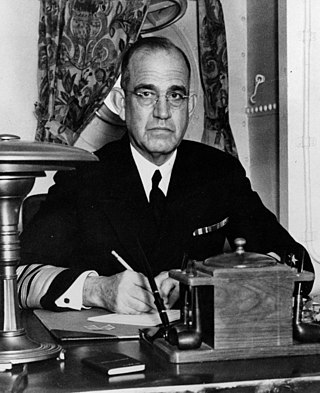
James Otto Richardson was an admiral in the United States Navy who served from 1902 to 1947.
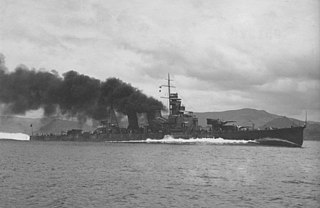
Aoba (青葉) was the lead ship in the two-vessel Aoba class of heavy cruisers in the Imperial Japanese Navy. Launched in 1926 and heavily modernized in 1938-40, Aoba initially served as a patrol craft, largely along the China coast, and saw extensive service during World War II. Repeatedly heavily damaged and repaired, she was finally crippled by bombing and settled on the bottom of shallow Kure harbor in April 1945; two raids in late July reduced her to an unsalvageable hulk. During the attack on 24 July 1945, future Vice admiral Dick H. Guinn dropped the 2,000 lb (910 kg) bomb which contributed to her sinking.
The Pacific War is a series of alternate history novels written by Newt Gingrich and William R. Forstchen with Albert S. Hanser. The series deals with the Pacific War between the United States of America and the Empire of Japan. The point of divergence is the decision of Admiral Isoroku Yamamoto, commander-in-chief of the Japanese Combined Fleet, to take personal command of the 1st Air Fleet for the attack on Pearl Harbor, rather than delegate it to Adm. Chūichi Nagumo.

A series of events led to the attack on Pearl Harbor. War between the Empire of Japan and the United States was a possibility each nation's military forces had planned for after World War I. The expansion of American territories in the Pacific had been a threat to Japan since the 1890s, but real tensions did not begin until the Japanese invasion of Manchuria in 1931.
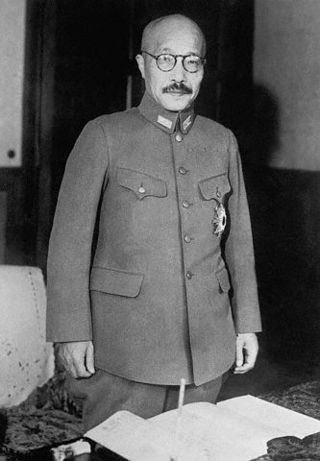
Japan's attack on Pearl Harbor took place on December 7, 1941. The United States military suffered 19 ships damaged or sunk, and 2,403 people were killed. Its most significant consequence was the entrance of the United States into World War II. The US had previously been officially neutral but subsequently entered the Pacific War, and after Italy's declaration of war and Germany's declaration of war shortly after the attack, the Battle of the Atlantic and the European theatre of war. Following the attack, the US interned 120,000 Japanese Americans, 11,000 German Americans, and 3,000 Italian Americans.
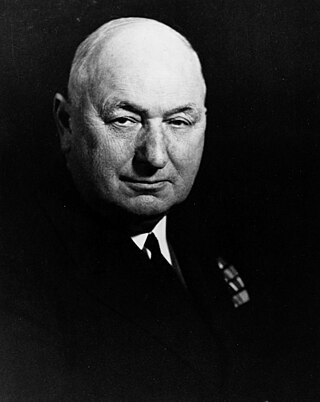
Edward Clifford Kalbfus, nicknamed "Old Dutch", was a four-star admiral in the United States Navy who was commander of the Battle Force of the United States Fleet from 1938 to 1939 and President of the Naval War College from 1934 to 1936 and 1939 to 1942.

Pearl Harbor is an American lagoon harbor on the island of Oahu, Hawaii, west of Honolulu. It was often visited by the naval fleet of the United States, before it was acquired from the Hawaiian Kingdom by the U.S. with the signing of the Reciprocity Treaty of 1875. Much of the harbor and surrounding lands are now a United States Navy deep-water naval base. It is also the headquarters of the United States Pacific Fleet. The U.S. government first obtained exclusive use of the inlet and the right to maintain a repair and coaling station for ships here in 1887. The surprise attack on the harbor by the Imperial Japanese Navy on December 7, 1941 led the United States to declare war on the Empire of Japan, marking the United States' entry into World War II.
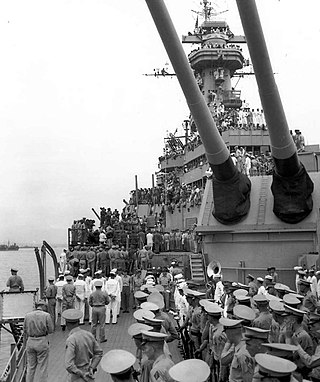
The United States Navy grew rapidly during its involvement in World War II from 1941–45, and played a central role in the Pacific War against Imperial Japan. It also assisted the British Royal Navy in the naval war against Nazi Germany and Fascist Italy. The U.S. Navy grew slowly in the years prior to World War II, due in part to international limitations on naval construction in the 1920s. Battleship production restarted in 1937, commencing with the USS North Carolina. The US Navy was able to add to its fleets during the early years of the war while the US was still neutral, increasing production of vessels both large and small, deploying a navy of nearly 350 major combatant ships by December 1941 and having an equal number under construction.
At the beginning of World War II, the Royal Navy was the strongest navy in the world, with the largest number of warships built and with naval bases across the globe. It had over 15 battleships and battlecruisers, 7 aircraft carriers, 66 cruisers, 164 destroyers and 66 submarines. With a massive merchant navy, about a third of the world total, it also dominated shipping. The Royal Navy fought in every theatre from the Atlantic, Mediterranean, freezing Northern routes to Russia and the Pacific ocean.

The attack on Pearl Harbor has received substantial attention in popular culture in multiple media and cultural formats including film, architecture, memorial statues, non-fiction writing, historical writing, and historical fiction. Today, the USS Arizona Memorial on the island of Oahu honors the dead. Visitors to the memorial reach it via boats from the naval base at Pearl Harbor. The memorial was designed by Alfred Preis, and has a sagging center but strong and vigorous ends, expressing "initial defeat and ultimate victory". It commemorates all lives lost on December 7, 1941.

Naval Base Hawaii was a number of United States Navy bases in the Territory of Hawaii during World War II. At the start of the war, much of the Hawaiian Islands was converted from tourism to a United States Armed Forces base. With the loss of US Naval Base Philippines in Philippines campaign of 1941 and 1942, Hawaii became the US Navy's main base for the early part of the island-hopping Pacific War against Empire of Japan. Naval Station Pearl Harbor was founded in 1899 with the annexation of Hawaii.